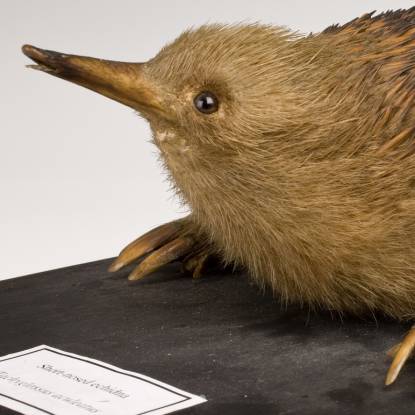Take me to:
at:
Let's go
Let's go
Halloween at UCL museums
4th October 2018
Museums
|


Something strange is happening at UCL museums this Halloween…
Take your pick of not one, but two eerie evening events. Drinks included and dressing up strongly encouraged!
Click here for a monstrous talk at the Petrie Museum of Egyptian Archaeology
Click here for a ghoulish late opening at the Grant Museum of Zoology
Share this:
Other articles like this one:

Fluff it Up: Make Taxidermy Great Again
21st Jul 2017
We've just this week launched a project called ‘Fluff it Up: Make Taxidermy Great Again’. We're taking some of our animals who need a bit of TLC out of the displays. While they're having a bit of love, we've made sure there's still things to look at by replacing them with some other kinds of stuffed animals, to highlight the important role of taxidermy conservation. [[{"fid":"4791","view_mode":"large","fields":{"format":"large","field_file_image_alt_text[und][0][value]":"Stuffed toy in Grant Museum","field_file_image_title_text[und][0][value]":"","field_caption_heading[und][0][title]":"","field_caption_heading[und][0][url]":"","field_caption[und][0][value]":"","field_caption[und][0][format]":"limited_html","field_float_left_right[und]":"none","field_file_image_decorative[und]":"0"},"type":"media","field_deltas":{"1":{"format":"large","field_file_image_alt_text[und][0][value]":"Stuffed toy in Grant Museum","field_file_image_title_text[und][0][value]":"","field_caption_heading[und][0][title]":"","field_caption_heading[und][0][url]":"","field_caption[und][0][value]":"","field_caption[und][0][format]":"limited_html","field_float_left_right[und]":"none","field_file_image_decorative[und]":"0"}},"link_text":null,"attributes":{"height":"1536","width":"2048","class":"media-element file-large"}}]]Taxidermy is a scientific art, requiring knowledge of anatomy and morphology, craftsmanship and accuracy to arrange, preserve and restore real animal skin over pre-made forms of the animal’s shape. [[{"fid":"4807","view_mode":"medium","fields":{"format":"medium","field_file_image_alt_text[und][0][value]":"Lucie Mascord","field_file_image_title_text[und][0][value]":"Lucie Mascord cleaning a platypus specimen","field_caption_heading[und][0][title]":"","field_caption_heading[und][0][url]":"","field_caption[und][0][value]":"%3Cp%3E%3Cem%3ELucie%20Mascord%20cleaning%20a%20platypus%20specimen%3C%2Fem%3E%3C%2Fp%3E","field_caption[und][0][format]":"limited_html","field_float_left_right[und]":"none","field_file_image_decorative[und]":"0"},"type":"media","field_deltas":{"1":{"format":"medium","field_file_image_alt_text[und][0][value]":"Lucie Mascord","field_file_image_title_text[und][0][value]":"Lucie Mascord cleaning a platypus specimen","field_caption_heading[und][0][title]":"","field_caption_heading[und][0][url]":"","field_caption[und][0][value]":"%3Cp%3E%3Cem%3ELucie%20Mascord%20cleaning%20a%20platypus%20specimen%3C%2Fem%3E%3C%2Fp%3E","field_caption[und][0][format]":"limited_html","field_float_left_right[und]":"none","field_file_image_decorative[und]":"0"}},"link_text":null,"attributes":{"height":"704","width":"500","class":"media-element file-medium"}}]]Many of our specimens at the Grant Museum are over a hundred years old, and they're going to need some specialist attention because of what time does to them. As Jack Ashby, Manager of the Grant Museum of Zoology explains “Given the rarity of the species in the wild, as well as the historic value of nineteenth and early twentieth century taxidermy, they would essentially be impossible to replace. This project will allow us to protect our incredible specimens for the long-term future.”“Historically, taxidermy has not always been very accurate – loose animal skins would be sent from collectors around the globe, and then mounted as taxidermy when they arrived in the UK – sometimes by people who had never actually seen the living creature. This can lead to animals being positioned in impossible poses, or being overstuffed” added Jack.The museum has around 75 examples of taxidermy, ranging in size from a chimpanzee to a pink fairy armadillo, including platypuses, koalas, turtles and pangolins. Some of the specimens to be treated include a chimpanzee from 1913 that has cracks along its face, a koala that is splitting to reveal wood shavings beneath the skin, and an inflated pufferfish that has lost its tail. However, not all of them will be repaired. “Our Australian echidna – a spiny relative of the platypus – has feet which point in the wrong direction and consequently, rips across the ankles. Echidnas were so unfamiliar to people in London that the taxidermist didn’t realise that their feet should point backwards. We won’t be correcting this mistake as it forms invaluable evidence of the ways these animals were historically understood,” said Jack. [[{"fid":"4815","view_mode":"medium","fields":{"format":"medium","field_file_image_alt_text[und][0][value]":"Echidna","field_file_image_title_text[und][0][value]":"","field_caption_heading[und][0][title]":"","field_caption_heading[und][0][url]":"","field_caption[und][0][value]":"","field_caption[und][0][format]":"limited_html","field_float_left_right[und]":"none","field_file_image_decorative[und]":"0"},"type":"media","field_deltas":{"1":{"format":"medium","field_file_image_alt_text[und][0][value]":"Echidna","field_file_image_title_text[und][0][value]":"","field_caption_heading[und][0][title]":"","field_caption_heading[und][0][url]":"","field_caption[und][0][value]":"","field_caption[und][0][format]":"limited_html","field_float_left_right[und]":"none","field_file_image_decorative[und]":"0"}},"link_text":null,"attributes":{"height":"477","width":"591","class":"media-element file-medium"}}]][[{"fid":"4799","view_mode":"medium","fields":{"format":"medium","field_file_image_alt_text[und][0][value]":"Twitter speculation","field_file_image_title_text[und][0][value]":"","field_caption_heading[und][0][title]":"","field_caption_heading[und][0][url]":"","field_caption[und][0][value]":"%3Cp%3E%3Cem%3ETwitter%20users%20respond%20to%20the%20Grant%20Museum%26%2339%3Bs%20Echidna%20specimen.%3C%2Fem%3E%3C%2Fp%3E","field_caption[und][0][format]":"limited_html","field_float_left_right[und]":"none","field_file_image_decorative[und]":"0"},"type":"media","field_deltas":{"1":{"format":"medium","field_file_image_alt_text[und][0][value]":"Twitter speculation","field_file_image_title_text[und][0][value]":"","field_caption_heading[und][0][title]":"","field_caption_heading[und][0][url]":"","field_caption[und][0][value]":"%3Cp%3E%3Cem%3ETwitter%20users%20respond%20to%20the%20Grant%20Museum%26%2339%3Bs%20Echidna%20specimen.%3C%2Fem%3E%3C%2Fp%3E","field_caption[und][0][format]":"limited_html","field_float_left_right[und]":"none","field_file_image_decorative[und]":"0"}},"link_text":null,"attributes":{"height":"330","width":"591","class":"media-element file-medium"}}]]‘Fluff It Up: Make Taxidermy Great Again’ is running until September, while the toys will replace the taxidermy in the displays.The Grant Museum of Zoology is open from 1–5pm Monday to Saturday. Visitors of the museum will have an opportunity to see conservation expert, Lucie Mascord, carrying out treatments on the specimens from the 12 -15 June. Admission is free and there is no need to book. “Taxidermy in museums plays an important role in engaging people with the natural world and its incredible biodiversity. We hope that the opportunity for people to see conservation first hand will inspire our visitors.” said Jack.

Museum team shortlisted for the UCL Education Awards
14th May 2024
[[{"fid":"16882","view_mode":"large","fields":{"format":"large","field_file_image_alt_text[und][0][value]":"A group of staff holding Education Awards in 2023.","field_file_image_title_text[und][0][value]":"","field_caption_heading[und][0][title]":"","field_caption_heading[und][0][url]":"","field_caption[und][0][value]":"","field_float_left_right[und]":"none","field_file_image_decorative[und]":"0"},"type":"media","field_deltas":{"1":{"format":"large","field_file_image_alt_text[und][0][value]":"A group of staff holding Education Awards in 2023.","field_file_image_title_text[und][0][value]":"","field_caption_heading[und][0][title]":"","field_caption_heading[und][0][url]":"","field_caption[und][0][value]":"","field_float_left_right[und]":"none","field_file_image_decorative[und]":"0"}},"attributes":{"height":"500","width":"800","class":"media-element file-large"}}]]Group nominations Improving the student experienceGrant Museum Curatorial Team: Tannis Davidson, Head of Zoology and Science CollectionsHannah Cornish, Curator (Zoology)Alice Holloway, Curatorial and Collections Assistant (Zoology).The Special Collections Reader Services team: Francisco Rafael Corrales Siodor, Library Assistant (Special Collections)Dan Mitchell, Library Assistant (Special Collections)Chelsie Mok, Teaching and Collections CoordinatorSarah Pipkin, Rare Books and Academic Liaison Librarian Mandy Wise, Reader Services ManagerRobert Winckworth, Senior Library Assistant (UCL Records & Special Collections)Daniel Dickins, Outreach and Exhibitions Coordinator Will Vaughan, UCL Bartlett Library AssistantCelebrating educationThe UCL Press textbook team: Dhara Snowden, Textbook Programme ManagerLara Speicher, Head of Publishing Jaimee Biggins, Production Manager.Alison Fox, Marketing and Distribution Manager.Enhancing belongingNeroli Harris, Training & Enquiry Support LibrarianAlong with the following colleagues from the Faculty of Life Sciences: Anika Ahmad, Sara Garfield, Cate Whittlesea, Robert Horne, Nitika Kapur, Maria Buck, Adam Phillips, Selva Athinarayanan Individual nominees Improving the student experienceFrancine Wood, Subject Liaison Librarian for Biosciences and PsychologyAbout the awardsThe annual Education Awards recognise and celebrate staff at UCL who make outstanding contributions to the learning experience and success of our students. New categories this year align with UCL’s ambitions for Education Excellence. The winners will be announced at an in-person ceremony on Wednesday 5 June 2024.UCL Education Awards 2024Go to the Learning and Teaching news page to view the full list of nominees and to book your ticket to the award ceremony.
Subscribe to our newsletter
 Close
Close

